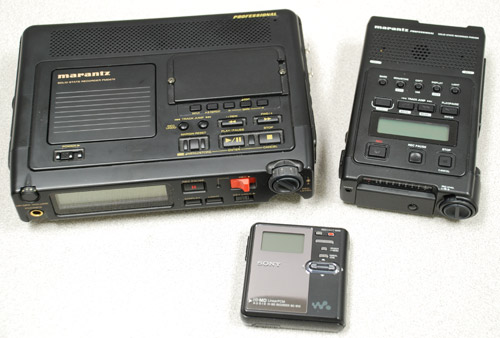By Peter Welander, Control Engineering process industries editor
One question that comes up regularly, and that I have struggled with myself, is that of what type of digital recorder to buy. Since most cost a few hundred dollars or more, it is a serious investment and not one most of us feel qualified to make intelligently. I have made some poorly informed purchases, so some of these lessons have been learned the hard way.

Three recorders from my personal collection: Marantz PMD670, Marantz PMD660, and Sony MZ-M10 MiniDisk. I’ve used all three extensively for various podcast projects. Each has its capabilities and drawbacks. Next week, we can begin to compare and contrast specific units according to the discussions here.
I’d like to approach this topic in at least two parts. First, establish a suggested general feature set, and then see how this yardstick applies to several examples. Please send your comments.
Dictation vs. music recorders
Dictation or speech recorders have specific capabilities:
- Higher compression rates (lower audio quality) to maximize recording time;
- Few choices of recording formats;
- Microphones optimized for speech;
- Might be mono or stereo;
- Pocket sized;
- Usually fixed recording media;
- Minimal connectivity; and
- Useful if you have a high end unit.
Music recorders are more versatile:
- Better microphones;
- More recording format options;
- Stereo recording, but this isn’t much help for podcasts;
- Better connectivity;
- Better control, but more complicated operation; and
- Bulkier and more expensive, relatively speaking, but usually worth it.
Inputs/Microphone(s)
Virtually any recorder has an internal mic (or two) or one that can be attached directly to the unit. These can be quite good and will likely be the means that you use for most of your recording. But sometimes you may want more. Look for these things:
- External mic input—Make sure there is a socket for an external mic. It will probably be a mini stereo plug, the same size as a normal headphone jack. You’ll need this for a phone interface, etc.
- External line input—This is a handy thing if you can get it, but not quite as important. It will help if you need to connect to a mixer or other audio source. Also probably a mini-stereo plug.
- “Pro” XLR mic input(s)—A few recorders have XLR mic inputs. Good if you plan on getting really serious, otherwise they just add bulk.
Recording media/transfer capability
- Fixed internal memory—Low end recorders do not have removable media. That’s fine if you don’t plan on recording much at any one time, but a problem if you can’t transfer files off and still have more to go.
- Thumb drive/SD card/CF card—These are all good and available virtually anywhere. SD and CF cards are usually carried internally and probably more practical.
- Mini-disk—This format (Sony) is rapidly going extinct. (I still have one.) It works well, but impossible to find disks when on the road.
- USB port—Don’t buy a recorder that does not have a standard USB port, if such even still exists. Also check to see if uploading files requires special software. Proprietary media and software can be a problem. Sony and Olympus have reputations for needing special stuff.
- Some recorders can actually function as a “USB microphone,” transferring directly to a computer live while recording.
Recording formats
The two most common and useful recording formats are MP3 and WAV (Linear PCM). Look at the specs for file format:
MP3 setting options should include:
- 44.1 kHz frequency;
- At least 64/128 (mono/stereo) kbps;
- Better with 80/160 kbps;
- Best with 128/256 kbps or higher.
WAV files with 16 bit at 44.1 kHz.
WMA or DSS formats are not the most useful. If this is all that is available, keep looking.
Headphones vs. speaker
It’s rare for small recorders to have a speaker of any value. It might be sufficient to identify a track but for any serious listening, you’ll need headphones or ear buds.
“Professional” vs. consumer
Professional ENG (electronic news gathering) recorders have some advantages, but some drawbacks too. What are they, what can they do, and are they worth it?
- Cost—ENG recorders begin at about $500, and can range into several thousand.
- Durability—They’re designed to get banged around in day-to-day use, so they’re more rugged.
- Inputs—Internal mics are usually low quality because you’ll be using external mics. Line in and out are standard.
- XLR connections—Designed for rugged professional mics and cables.
- Formats—Usually a wide range of recording formats with removable storage card media. Some have four tracks.
- Bulk—They’re big and often heavy. Operation can be complicated.
Should you buy one? If you’re really serious, yes. You can control the recording quality and extend the versatility of your projects. There’s the psychological benefit of pulling one our of your bag because it shows anyone that you’re recording that you mean business, assuming you don’t fumble with trying to make it work. Bear in mind the recorder is just the beginning. You’ll also need microphones, cables, headphones, etc. There are used units available on eBay and similar sites that can help you get started.
These comments should not be considered the final word. There are many factors and personal preference issues that come into these decisions. At the same time, when I was starting out in this, I would have appreciated some guidance that might have saved me a few (hundred) bucks. So take it for what it’s worth. If you have other observations, I’d love to hear them.
